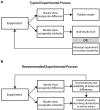Recommendations for sex/gender neuroimaging research: key principles and implications for research design, analysis, and interpretation
- PMID: 25221493
- PMCID: PMC4147717
- DOI: 10.3389/fnhum.2014.00650
Recommendations for sex/gender neuroimaging research: key principles and implications for research design, analysis, and interpretation
Abstract
Neuroimaging (NI) technologies are having increasing impact in the study of complex cognitive and social processes. In this emerging field of social cognitive neuroscience, a central goal should be to increase the understanding of the interaction between the neurobiology of the individual and the environment in which humans develop and function. The study of sex/gender is often a focus for NI research, and may be motivated by a desire to better understand general developmental principles, mental health problems that show female-male disparities, and gendered differences in society. In order to ensure the maximum possible contribution of NI research to these goals, we draw attention to four key principles-overlap, mosaicism, contingency and entanglement-that have emerged from sex/gender research and that should inform NI research design, analysis and interpretation. We discuss the implications of these principles in the form of constructive guidelines and suggestions for researchers, editors, reviewers and science communicators.
Keywords: brain imaging; essentialism; gender; plasticity; sex differences; sex similarities; stereotypes.
Figures



References
-
- Adkins-Regan E. (2005). Hormones and Animal Social Behavior. Princeton, NJ, Princeton: University Press
Publication types
LinkOut - more resources
Full Text Sources
Other Literature Sources

